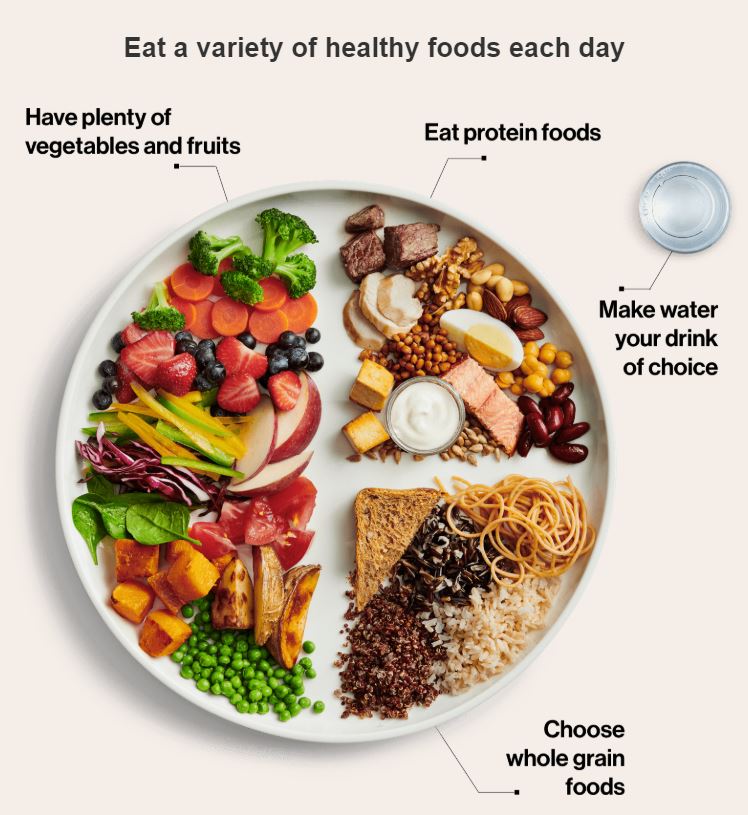Canada’s long-anticipated revised food guide was released Tuesday morning, and it has some big changes from previous guidance on healthy eating.

As hinted at in public consultations and draft documents, the new guide does away with the four food groups and advice on the number of servings to eat each day – something even Health Canada says people found confusing in the last food guide.
In consultations, Health Canada heard that the recommendations to eat a particular number of portions of a particular size were too complicated, said Dr. Hasan Hutchinson, director general of the Office of Nutrition Policy and Promotion at Health Canada, which prepared the new guidelines.
READ MORE: Canada’s new food guide trims down on dairy — should you?
“It wasn’t particularly helpful to incorporate into their everyday lives,” Hutchinson said.
“We are taking a new approach that we think is going to be very helpful.”
Instead of specific serving recommendations, the new guide presents a number of general guidelines to eat by. Here’s a look at some of them.
Eat a variety of healthy foods each day
Specifically, the new food guide suggests eating plenty of vegetables and fruits, choosing whole grains, and eating “protein foods.”
When picking proteins, the food guide suggests eating plant-based proteins, like legumes, beans, and tofu more often than those from animal sources, like dairy, eggs, meat and fish.
“Milk and alternatives” and “meat and alternatives” were two of the four food groups in the last food guide, but this time, they were lumped together. Dairy definitely isn’t missing, as Health Canada provides lower-fat milk, yogurt, kefir and cheese as examples of protein food. Lean red meat, like game, is also mentioned. They’re just less special now, as just two of many protein choices.
WATCH: Health Minister Ginette Petitpas-Taylor unveiled Canada’s long-anticipated revised food guide on Wednesday morning.

When it comes to drinks, the food guide recommends making water your beverage of choice. This is partly about preventing dehydration, but also partly about limiting sugar intake, according to Health Canada officials. If you’re drinking more water, you’re probably drinking less juice and pop.
“Water supports health and prevents dehydration, without adding more calories to the diet,” Hutchinson said.
One of the “at-a-glance” documents in the new food guide shows a plate, with one half covered in vegetables and fruit, one quarter protein, and one quarter whole grains, which Hutchinson calls a “wonderful” message.
“It’s not about portion, per se, but perhaps about proportion,” he said.
WATCH: Canada’s Food Guide is getting a major overhaul, and putting a big spotlight on healthier eating. As Alicia Draus reports, the new changes have been long awaited.
_848x480_1430109251750.jpg?w=1040&quality=70&strip=all)
Avoid processed foods and beverages that are high in sodium, sugar and saturated fat
These foods “undermine healthy eating” according to the food guide, so should generally be avoided. Some examples of these kinds of foods include processed meats like hot dogs, deep-fried food, sugary breakfast cereal and sugary drinks.
A recent report from Statistics Canada found that sugary drinks were the top source of sugar intake for Canadians, though overall sugar consumption has been decreasing.
Instead of pop and candy, most dietary sugar should come from whole fruits and vegetables and unsweetened milk, the food guide says.
The food guide also notes that alcohol is high in calories with “little to no nutritive value” and is associated with a variety of health risks like an increased risk of several cancers, hypertension and liver disease.
They also want Canadians to use food labels to judge how healthy or unhealthy a product is, and to be aware of food marketing and its possible impact on their purchase choices. As part of the overall healthy eating strategy, Health Canada proposed new food labels in 2018 that would make it easier to spot foods high in sodium, sugar and saturated fat.
- Shoppers faces proposed class action over claims company is ‘abusive’ to pharmacists
- Most Canadian youth visit dentists, but lack of insurance a barrier
- ‘Bacterial vampirism’: Deadly pathogens attracted to human blood, study finds
- Budget 2024: Liberals look to offset drug plan cost with higher smoking, vaping taxes
Cook more often and eat meals with others
The new food guide emphasizes home cooking as a practical way to support healthy eating. “Over time, Canadian households have significantly increased the proportion of their food budget spent on highly processed products,” says the guide, and Canadian households also spend about 30 per cent of their food budget on meals and snacks purchased outside the home.
These foods are associated with higher sugar, sodium, calories and saturated fat, they say – many of the things they want Canadians to avoid.
Cooking at home also helps pass cooking skills on to children, the guide’s authors write, as does sharing meals with others.
Be mindful of your eating habits – but enjoy your food
Health Canada recommends that people take time to eat, and notice when they’re hungry and when they’re full.
They also want people to enjoy their food. “Culture and food traditions can be part of healthy eating.”


Comments